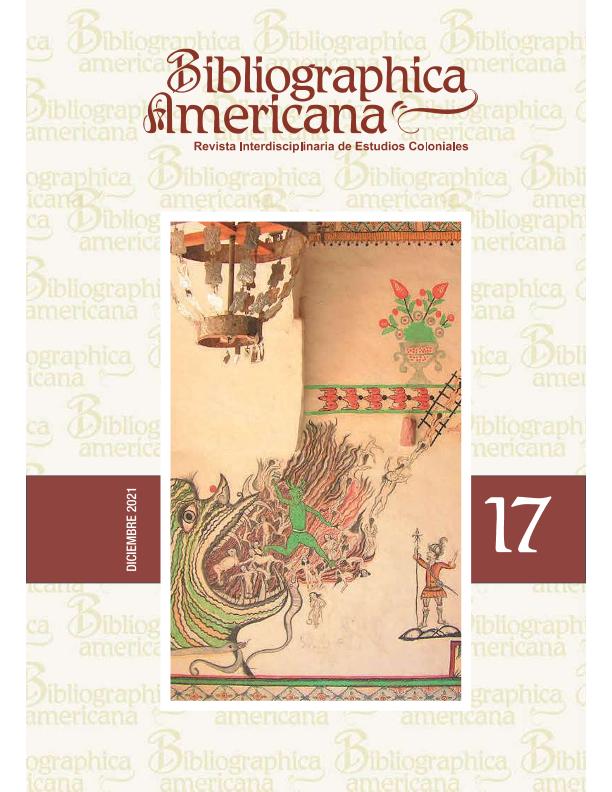Mostrar el registro sencillo del ítem
dc.contributor.author
Tomasini, Eugenia Paula

dc.date.available
2022-08-25T17:55:40Z
dc.date.issued
2021-12
dc.identifier.citation
Tomasini, Eugenia Paula; Procesos de identificación y caracterización de pigmentos usados en pintura mural andina colonial; Biblioteca Nacional de la República Argentina "Mariano Moreno"; Bibliographica Americana; 17; 17; 12-2021; 45-62
dc.identifier.issn
1668-3684
dc.identifier.uri
http://hdl.handle.net/11336/166622
dc.description.abstract
El estudio de estas pinturas murales coloniales representa un paso importante para comprender la disponi-bilidad de las materias primas a las que los artistas del momento tuvieron acceso. Cuando se identifican los pigmentos en este tipo de imágenes es importante determinar su origen, lo que permite establecer relaciones culturales y geográficas. Las pinturas murales coloniales se encuentran en iglesias situadas en una antigua carretera comercial que unía las ciudades de Potosí en Bolivia con Arica en Chile, conocida como la Ruta de la Plata, entre los siglos XVI y XVIII. Se presentarán aquí los resultados sobre la aplicación de diferentes técnicas analíticas que formaron parte de los procesos de identificación y caracterización de los pigmentos rojos, amarillos, naranjas, azules, negros y verdes, y que permitieron determinar la técnica de pintura mural usada. Los estudios se realizaron sobre micromuestras extraídas de los murales utilizando la espectroscopia micro-Raman e infrarroja (FTIR-ATR), complementada con la espectroscopia de fluorescencia de rayos X (FRX) y microscopia electrónica de barrido con análisis espectroscópico de dispersión de energía (SEM-EDS). En este trabajo se presentan estudios químicos realizados, entre los cuales algunos fueron publicados, sobre muestras de pintura mural de algunas iglesias andinas de la Ruta de la Plata. Estos estudios se vinculan con un proyecto llevado a cabo en conjunto con investigadores de Chile, Bolivia y Argentina, y se destacan por ser el resultado de un trabajo sinérgico entre profesionales de la química, historia y conservación, basada en la discusión inmediata e interdisciplinaria de los resultados que se obtienen con aportes valiosos desde cada área.
dc.description.abstract
The study of these colonial wall paintings represents an important step towards understanding the availabi-lity of the raw materials to which the artists of the time had access. When pigments are identified in such images, it is important to determine their origin, which allows cultural and geographical relationships to be established. Colonial mural paintings are found in churches located on an ancient trade road that connected the cities of Potosí in Bolivia with Arica in Chile, known as the Silver Route, between the 16th and 18th centuries. The results of the application of different analytical techniques that were used in the processes of identification and characterisation of the red, yellow, orange, blue, black and green pigments, and which made it possible to determine the mural painting technique used, will be presented here. The studies were carried out on micro-samples extracted from the murals using micro-Raman and infrared spectroscopy (FTIR-ATR), complemented by X-ray fluorescence spectroscopy (XRF) and scanning electron microscopy with energy dispersive spectroscopic analysis (SEM-EDS). This paper presents chemical studies carried out, some of which have been published, on samples of mural paintings from some Andean churches along the Silver Route. These studies are linked to a project carried out jointly with researchers from Chile, Bolivia and Argentina, and stand out for being the result of synergistic work between professionals in chemistry, history and conservation, based on the immediate and interdisciplinary discussion of the results obtained with valuable contributions from each area.
dc.format
application/pdf
dc.language.iso
spa
dc.publisher
Biblioteca Nacional de la República Argentina "Mariano Moreno"
dc.rights
info:eu-repo/semantics/openAccess
dc.rights.uri
https://creativecommons.org/licenses/by-nc-sa/2.5/ar/
dc.subject
MURALES ANDINOS COLONIALES
dc.subject
PIGMENTOS
dc.subject
TECNICAS ANALITICAS
dc.subject
RUTA DE LA PLATA
dc.subject.classification
Otras Ciencias Químicas

dc.subject.classification
Ciencias Químicas

dc.subject.classification
CIENCIAS NATURALES Y EXACTAS

dc.subject.classification
Arte, Historia del Arte

dc.subject.classification
Arte

dc.subject.classification
HUMANIDADES

dc.title
Procesos de identificación y caracterización de pigmentos usados en pintura mural andina colonial
dc.type
info:eu-repo/semantics/article
dc.type
info:ar-repo/semantics/artículo
dc.type
info:eu-repo/semantics/publishedVersion
dc.date.updated
2022-08-25T13:50:48Z
dc.journal.volume
17
dc.journal.number
17
dc.journal.pagination
45-62
dc.journal.pais
Argentina

dc.journal.ciudad
Ciudad Autónoma de Buenos Aires
dc.description.fil
Fil: Tomasini, Eugenia Paula. Consejo Nacional de Investigaciones Científicas y Técnicas; Argentina. Universidad Nacional de Tres de Febrero. Instituto de Investigaciones en Arte y Cultura "Dr. Norberto Griffa"; Argentina
dc.journal.title
Bibliographica Americana
dc.relation.alternativeid
info:eu-repo/semantics/altIdentifier/url/https://www.bn.gov.ar/micrositios/revistas/bibliographica/bibliographica-americana-15
Archivos asociados
